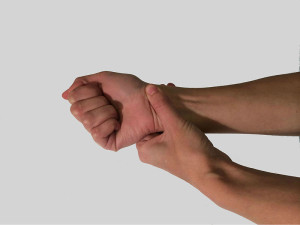Acupuncture alleviates carpal tunnel syndrome and heals injured peripheral nerves. Electromyography, nerve conductions studies, and ultrasonic imaging confirms that acupuncture combined with moxibustion improves electrophysiological peripheral nerve responses and repairs peripheral nerve tissues for patients with carpal tunnel syndrome (CTS). In addition, the researchers (Ding et al.) recorded significant pain relief in clinical observations using a numerical rating scale. Ding et al. conclude that objective and subjective testing demonstrates that acupuncture plus moxibustion is effective for the treatment of carpal tunnel syndrome. The detailed research was published in the Journal of Clinical and Experimental Medicine.
 Carpal tunnel syndrome is due to median nerve compression. This nerve entrapment may cause pain, numbness, and weakness of the forearm, wrist, and hand. Some patients experience difficulty in discerning hot from cold sensations and others experience deterioration of local tendons, muscles, ligaments, and sinew. Ding et al. demonstrate that acupuncture plus moxibustion alleviates pain and heals damaged tissues for patients with carpal tunnel syndrome. Let’s review the acupuncture and moxibustion procedures that achieved these important results. First, a quick look at the some of the testing procedures.
Carpal tunnel syndrome is due to median nerve compression. This nerve entrapment may cause pain, numbness, and weakness of the forearm, wrist, and hand. Some patients experience difficulty in discerning hot from cold sensations and others experience deterioration of local tendons, muscles, ligaments, and sinew. Ding et al. demonstrate that acupuncture plus moxibustion alleviates pain and heals damaged tissues for patients with carpal tunnel syndrome. Let’s review the acupuncture and moxibustion procedures that achieved these important results. First, a quick look at the some of the testing procedures.
Ding et al. reveal a multiplicity of findings. Acupuncture combined with moxibustion healed median nerve transection areas (MNTA). Distal motor latency (DML) of the median nerve and thumb-to-wrist sensory conduction velocity (SCV) improved significantly. Improvements in nerve transmissions were confirmed with motor conduction velocity (MCV), compound muscle action potential (CMAP), sensory nerve action potential (SNAP), sensory conduction velocity (SCV), and distal motor latency (DML) electrodiagnostic tests. High-resolution ultrasound imaging demonstrated significant improvements in the transverse carpal ligament (TTCL) and median nerve transection areas.
Acupuncture was applied with patients relaxing in a seated position with the elbow slightly bent. The palm rested on the treatment table in a face up position. First, acupoints on the yang meridians were applied followed by acupoints on the yin meridians. Mild reinforcing and reducing manual acupuncture techniques were applied until the arrival of deqi. The needles were stimulated with manual acupuncture techniques every ten minutes during the thirty minute treatment sessions. Acupuncture was applied once per day, five days per week, for two weeks. This process was repeated two times for a total of thirty acupuncture treatment sessions over a six week period of time.
Note that Wailaogong (Outer Laogong) is on the posterior of the hand opposite PC8. Although also considered identical with Luozhen (Ex-UE-8), the application of Wailaogong in this instance is at its location at the midpoint of a line connecting the wrist and the third metacarpal bone head, between the metacarpal bones, and directly opposite PC8. Needling was applied to Wailaogong through to PC8.
Moxibustion was applied by lighting a smokeless moxa cigar and placing it into a moxibustion box. The box was then used to heat the acupoints for thirty minutes in a hovering motion. The researchers examined the clinical data and determined that acupuncture plus moxibustion is effective for the treatment of carpal tunnel syndrome.
Excerpt from:
